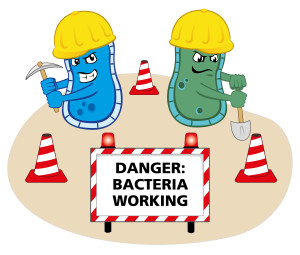Written By: Robert C. Jerris, Ph.D. D (ABMM)
Children’s Healthcare of Atlanta, Emory University School of Medicine, Atlanta, GA

A simple tubing trip down a rushing river; an encounter with a rock resulting in a small abrasion on the knee; a life threatening cellulitis due to a multi-drug resistant Gram negative rod. This scene and others play out every day across the globe. It is estimated that more than 2 million people in the United States are infected with antibiotic-resistant organisms with a conservative estimate of 23,000 deaths.
Antimicrobial resistance in microorganisms is one of our most serious global threats. In this review, we detail key organisms, their mechanisms of resistance, therapeutic options and control measures. Rates and numbers have been extracted from: CDC, Antibiotic Resistance Threats in the United States, 2013, with therapeutic options and control measures from multiple sources including our own experiences.
- Clostridium difficile
- Resistance: Innately resistant to many antimicrobics routinely used to treat other infections; imbalance in GI tract flora with overgrowth of C. difficile leading to diarrhea; spread by spores, making it difficult to contain.
- Prevalence: Estimated 250,000 infections with 14,000 deaths.
- Therapeutic options: Metronidazole; vancomycin; fidaxomycin; stool transplant.
- Control measures: Appropriate diagnostic testing (nucleic acid amplification tests); Hospital hygiene for employees (soap and water, not ethanol) and thorough terminal cleaning to include bleach; clinicians- judicious use of antimicrobics (See http://www.cdc.gov/getsmart/ for online resource); patient compliance- take antimicrobics only as prescribed.
- Carbapenem Resistant Enterobacteriaceae
- Resistance: Production of a carbapenemase that inactivates these broad-spectrum antibiotics (imipenem, meropenem, ertapenem, doripenem); often resistant to multiple other classes of antimicrobics.
- Prevalence: Estimated 9,000 infections per year and growing, with 600 deaths.
- Therapeutic options: Very limited; combination therapy; polymixins, aminoglycosides.
- Control measures: Critical to have adequate laboratory testing for detection; hospital hygiene as above; appropriate infection control; see http://www.cdc.gov/HAI/organisms/cre/index.html for online resource.
- Neisseria gonorrheae
- Resistance: Cefixime (<1%), ceftriaxone (<1%), azithromycin (<1%), tetracycline (23%).
- Prevalence: Estimated about 250,000 isolates resistant to any drug.
- Therapeutic options: Ceftriaxone plus either azithromycin or doxycycline
- Control measures: Accurate prompt identification of organisms; treatment of patient and contacts; reporting to public health agency as a notifiable disease.
See Morbidity and Mortality Weekly Report 2012; 61(31): 590-594 for updated guidelines.
- Multidrug Resistant Acinetobacter spp.
- Resistance: It is estimated that approximately 63% of this species are resistant to 3 or more classes of antimicrobics.
- Prevalence: Associated with 2% of all hospital acquired infections with rates as high as 7% in patients on mechanical ventilation with estimates of 7,000 infections and 500 deaths annually.
- Therapeutic options: Based on routine laboratory susceptibility testing.
- Control measures: Follow institutional policies for multi-drug resistant organisms (MDRO); See http://www.cdc.gov/hicpac/mdro/mdro_0.html.
- Campylobacter spp.
- Resistance: Azithromycin (2%) and ciprofloxacin (23%).
- Prevalence: 1.3 million infections, 13,000 hospitalizations, and 120 deaths each year in the United States.
- Therapeutic options: Treatment controversial; normally self-limiting; erythromycin when used early eliminates bacteria but may not reduce length of illness; sequelae-Guillan Barre Syndrome (1 in 1058, more frequent based on serotype).
- Control measures: Home health hygiene-thoroughly clean cutting boards/utensils, sinks, and counter tops, wash hands; Be smart- keep uncooked food (meat, chicken, seafood) away from ready to eat foods; cook food adequately; refrigerate food promptly; do not drink raw milk or untreated water. http://wwwnc.cdc.gov/eid/article/7/1/70-0024_article.
- Extended spectrum beta-lactamase (ESBL) producing Enterobacteriaceae
- Resistance: ESBL producers are resistant to all penicillins, cephalosporins and monobactams.
- Prevalence: Approximately 19,000 cases of hospital associated infections annually with 1,700 deaths.
- Therapeutic options: Carbapenems; depending on susceptibility -fluoroquinolones may be a choice.
- Control measures: Adequate laboratory methods to detect ESBLs; follow MDRO infection control guidelines. See http://www.cdc.gov/hicpac/mdro/mdro_0.html.
- Vancomycin Resistant Enterococcus(VRE)
- Resistance: Vancomycin (100%).
- Prevalence: Estimated 20,000 hospital associated infections per year with 1,300 deaths.
- Therapeutic options: Based on laboratory susceptibility testing.
- Control measures: Follow institutional policies.
- Multidrug Resistant Pseudomonas aeruginosa
- Resistance: Many strains are now resistant to aminoglycosides, beta-lactams, fluoroquinolones and carbapenems.
- Prevalence: 8% of all hospital-associated infections are P. aeruginosa with 13% of these as MDRO, approximately 440 deaths.
- Therapeutic options: Based on routine laboratory testing.
- Control measures: Follow institutional policies for MDRO.
- Drug resistant non- typhoid Salmonella spp.
- Resistance: Ceftriaxone (3%), ciprofloxacin (3%), resistant to more than 5 drug classes (5%).
- Prevalence: Approximately 1.2 million cases of non-typhoid Salmonella infections each year with 450 deaths; of these, approximately 100,000 cases of resistance each year with 38 deaths.
- Therapeutic options: Based on routine laboratory testing.
- Control measures: Home health hygiene-thoroughly clean cutting boards/utensils, sinks, and counter tops, wash hands; Be smart- keep uncooked food (meat, chicken, seafood) away from ready to eat foods; cook food adequately; refrigerate food promptly; do not drink raw milk or untreated water.
- Drug resistant Salmonella Typhi
- Resistance: Ceftriaxone, azithromycin, ciprofloxacin.
- Prevalence: 21.7 million cases of typhoid worldwide each year. Most of the 5,700 cases in the US as imported cases.
- Therapeutic options: Based on routine laboratory testing.
- Control measures: Vaccine for those travelling in endemic areas. Adhere to safe travel hygiene and practices: consume safe foods and water; do not eat raw fruits or vegetables; do not consume cold foods or beverages from street vendors.
- Drug resistant Shigella spp.
- Resistance: Ciprofloxacin (3%), azithromycin (3%).
- Prevalence: 500,000 cases of Shigella annually; 5,500 hospitalizations; 40 deaths.
- Therapeutic options: Fluids for mild cases; base treatment on routine laboratory testing.
- Control measures: Home hygiene; consumption of safe foods and water when travelling.
- Methicillin Resistant Staphylococcus aureus
- Resistance: All penicillins, cephalosporins, beta-lactam/beta-lactamase inhibitors, carbapenems, monobactams.
- Prevalence: Over 80,000 cases with over 11,000 deaths annually.
- Therapeutic options: Vancomycin, clindamycin, trimethoprim/sulfamethoxazole (cautious use).
- Control measures: Handwashing; appropriate infection control; see http://www.cdc.gov/mrsa/ for online resource.
- Drug resistant Streptococcus pneumoniae
- Resistance: Trimethoprim/sulfamethoxazole, penicillins, cephalosporins, erythromycins, clindamycin.
- Prevalence: A total of 4 million cases of pneumococcal disease, with 22,000 deaths annually; 1.2 million cases, 7,000 deaths due to resistant strains.
- Therapeutic options: Fluoroquinolones (not ciprofloxacin) remain active; base others antimicrobics on laboratory susceptibility testing.
- Control measures: Vaccine; www.cdc.gov/pneumococcal .
- Drug resistant Tuberculosis
- Resistance: Isoniazid (7%), Multi-drug resistance: first line drugs (isoniazid, rifampin) [10%], X-drug resistant: the above plus fluoroquinolone and to any of the three second-line injectable drugs (i.e., amikacin, kanamycin, capreomycin) [<1%].
- Prevalence: 10,528 cases of TB in the US in 2011, antibiotic resistance was identified in 1,042, or 9.90%.
- Therapeutic options: Based on laboratory susceptibility testing.
- Control measures: See http://www.tbcontrollers.org/ for online resource.
- Miscellaneous others
- Vancomycin resistant Staphylococcus aureus: 13 cases in 4 states; see http://www.cdc.gov/HAI/organisms/visa_vrsa/visa_vrsa.html.
- Erythromycin/clindamycin gp A streptococcus : Approximately 1-2.6 million cases of strep throat each year, 1,300 resistant strains with 160 deaths; erythromycin class-10% resistant, clindamycin – 3.4% resistant (detected by routine and d-zone laboratory testing); see http://www.cdc.gov/abcs/index.html.
- Clindamycin resistant gp B streptococcus: Erythromycin- 49% resistant, clindamycin 28% resistant (detected by routine and d-zone laboratory testing); 27,000 cases with 7,600 resistant strains and 440 deaths.
Special thanks to Matthew C. Jerris, Pharm.D for perspectives on treatment, and J. Michael Miller, Ph.D. D(ABMM) for critical review.
Biography
 Robert C. Jerris, PhD is Director of Clinical Microbiology at Children’s Healthcare of Atlanta at Egleston and Scottish Rite Hospitals. A diplomate of the American Board of Medical Microbiology, Dr. Jerris formerly served for 20 years as Director of Clinical Microbiology Laboratories at DeKalb Medical Center in Decatur, Georgia. He is also a Clinical Associate Professor in the Department of Pathology and Laboratory Medicine at Emory University School of Medicine. Dr. Jerris was the lead U.S. scientist for the implementation of automated blood culturing to rural Guatemala with the Emerging Infections Program at the Centers for Disease Control and Prevention. He was a member of the Board of the College of the American Academy of Microbiology and currently serves on the Public and Scientific Affairs Board of the American Society for Microbiology. A prolific writer and researcher, Dr. Jerris received his doctorate in experimental pathology from Emory University and his bachelor of science degree in microbiology and medical technology from Florida State University.
Robert C. Jerris, PhD is Director of Clinical Microbiology at Children’s Healthcare of Atlanta at Egleston and Scottish Rite Hospitals. A diplomate of the American Board of Medical Microbiology, Dr. Jerris formerly served for 20 years as Director of Clinical Microbiology Laboratories at DeKalb Medical Center in Decatur, Georgia. He is also a Clinical Associate Professor in the Department of Pathology and Laboratory Medicine at Emory University School of Medicine. Dr. Jerris was the lead U.S. scientist for the implementation of automated blood culturing to rural Guatemala with the Emerging Infections Program at the Centers for Disease Control and Prevention. He was a member of the Board of the College of the American Academy of Microbiology and currently serves on the Public and Scientific Affairs Board of the American Society for Microbiology. A prolific writer and researcher, Dr. Jerris received his doctorate in experimental pathology from Emory University and his bachelor of science degree in microbiology and medical technology from Florida State University.





0 Comments
Trackbacks/Pingbacks